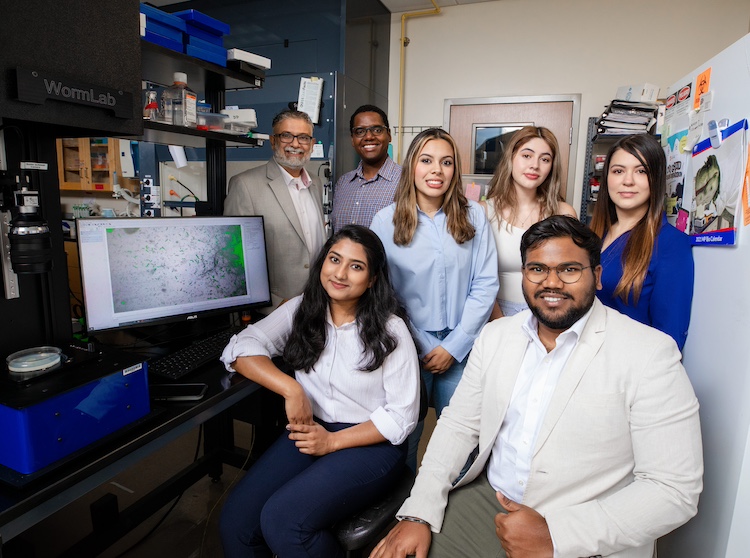
Nanoplastics and ‘Forever Chemicals’ Disrupt Molecular Structures, Functionality
Both compounds alter critical proteins in breast milk, infant formulas, more, UTEP study shows
EL PASO, Texas (July 11, 2024) – Researchers at The University of Texas at El Paso have made significant inroads in understanding how nanoplastics and per- and polyfluoroalkyl substances (PFAS) — commonly known as forever chemicals — disrupt biomolecular structure and function. The work shows that the compounds can alter proteins found in human breast milk and infant formulas — potentially causing developmental issues downstream.

Nanoplastics and forever chemicals are manmade compounds present throughout the environment; a series of recent studies have linked them to numerous negative health outcomes. While nanoplastics originate primarily as a result of the degradation of larger plastic materials, like water bottles and food packaging, forever chemicals are found in various products like cookware and clothing.
The UTEP research team focused on the compounds’ impact on three proteins critical to human development and function: beta-lactoglobulin, alpha-lactalbumin and myoglobin. Their findings, which provide an atomic-level insight into the detrimental effects of nanoplastics and PFAS on human health, are described in two recent articles in the Journal of the American Chemical Society and ACS Applied Materials and Interfaces.
“By understanding the molecular mechanisms of how nanoplastics and forever chemicals disrupt cellular functions, scientists can develop safer alternatives to these materials,” said Mahesh Narayan, Ph.D., a professor, fellow of the Royal Society of Chemistry and chief of the Division of Biochemistry in UTEP’s Department of Chemistry and Biochemistry, who oversaw the two studies. “The insights gained from this research have far-reaching implications.”
Narayan said that, most importantly, their research revealed that nanoplastics and PFAS completely “dissolved” a region of proteins known as the alpha helix, converting them into structures called beta sheets.
“We weren’t expecting them all to have this similar impact on the alpha helix,” Narayan said. “It was a complete coincidence.” The team observed that this alteration also occurs in amyloid proteins, which can cause neurodegeneration and neurotoxic outcomes if the synthetic chemicals reach the brain.
Additional key findings of the studies are described below.
Milk Protein: Beta-Lactoglobulin (BLG)
BLG is a protein found in the milk of sheep and cows and is commonly used as an ingredient in infant formula. The protein binds to retinol (vitamin A) and fatty acids and is crucial for vision and brain development in infants.
The research team discovered that the binding efficiency of BLG to retinol and fatty acids decreases upon exposure to nanoplastics and PFAS. This decrease, modeled by Lela Vukovic, Ph.D., associate professor in the Department of Chemistry and Biochemistry, can lead to significant developmental issues in neonatal infants, the team said.
Additionally, for the first time ever, the team observed that PFAS binds to the milk protein, turning it into a carrier for these compounds.
Human Breast Milk: Alpha-Lactalbumin
Alpha-lactalbumin is found in human breast milk, participates in lactose synthesis and is ingested by infants to help meet nutritional needs. UTEP researchers found that nanoplastics and PFAS corrupt the structure of alpha-lactalbumin protein, thereby potentially compromising lactose formation. The team said the disruption can lead to downstream developmental defects in neonatal infants, such as compromised immunity and reduced mineral absorption.
Oxygen Storage: Myoglobin
Myoglobin, found in the blood and muscle tissue of most mammals, is crucial for storing oxygen. The UTEP research team found that nanoplastics and PFAS compromise the functionality of the myoglobin protein, disrupting its ability to store oxygen. This disruption could lead to health issues such as breathlessness and anemia.
Additional experiments by the team demonstrated that exposure to nanoplastics impairs locomotion in worms, with effects comparable to paraquat — an herbicide that has been tied to causing Parkinson’s disease.
“This work has the potential to significantly impact public health and environmental policies, highlighting the vital role of scientific research in addressing global challenges,” said Robert Kirken, Ph.D., dean of the College of Science. “I am proud of the groundbreaking research conducted by Dr. Narayan, Dr. Vukovic and their teams. Their innovative approach to understanding how these manmade materials disrupt biomolecular functions is a prime example of the transformative work UTEP researchers do on a regular basis.”
Narayan and his research team plan to continue their studies and investigate the effects of other plastics and PFAS compounds.
About The University of Texas at El Paso
The University of Texas at El Paso is America’s leading Hispanic-serving university. Located at the westernmost tip of Texas, where three states and two countries converge along the Rio Grande, 84% of our 24,000 students are Hispanic, and more than half are the first in their families to go to college. UTEP offers 170 bachelor’s, master’s and doctoral degree programs at the only open-access, top-tier research university in America.
Last Updated on July 11, 2024 at 12:00 AM | Originally published July 11, 2024
By MC Staff UTEP Marketing and Communications
